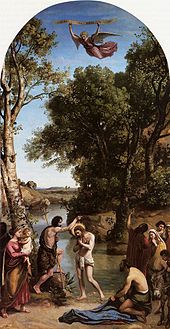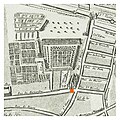St-Nicolas-du-Chardonnet
The Saint-Nicolas-du-Chardonnet church is located on the corner of Rue des Bernardins and Rue Saint-Victor in Paris' 5th arrondissement . Since February 27, 1977 the church has been occupied by supporters of the Brotherhood of St. Pius ( Fraternité sacerdotale Saint-Pie-X ); Today the church is the most important place of worship for Catholic traditionalism and for Catholic groups within the extreme right in Paris.
history
The church was built in the 13th century on the western edge of the Terres d'Aletz and Fief du Chardonnet ( French chardons = thistles ) lying between Bièvre and Seine , which was originally under the Abbey of Saint-Victor . This area was divided by the construction of the city wall of King Philip Augustus (1180-1223), the abbey remained outside the city (Faubourg Saint-Victor), but inside the walls there was space for the church, the Collège des Bernardins (1245 ) and the Collège du Cardinal Lemoine (1303).
When exactly Saint-Nicolas-du-Chardonnet was built is controversial in research, as different documents from the period between 1230 and 1246 are interpreted differently and there is no consensus as to whether they refer to this church or the neighboring sacred buildings. All that is certain is that the Saint-Nicolas church donated to the Île de la Cité by Robert the Pious († 1031) was demolished in 1242 in order to build the Sainte-Chapelle on the same site , and it is assumed that Saint-Nicolas du-Chardonnet was a replacement (whether as a building or as a change of patronage has not been clarified), as Nikolaus von Myra was venerated as patron of seafarers, traders, schoolchildren and students in Paris .
In 1625 the bell tower was rebuilt, between 1656 and 1763 the entire church as it is today, next to the old church, which was also left to decay. For reasons of space, it was decided to build the new church in a north-south direction. In 1656 the foundation stone was laid in the cemetery north of the old church. Charles Lebrun (1619–1690) was the best known artist who worked on the new church. The nave was completed in 1716, the keystone of the vault was set in 1763, and the main altar was consecrated on December 4, 1768 by Archbishop Christophe de Beaumont . The long construction period is due to financial bottlenecks that were offset by royal lotteries (1703 and 1763).

The organ was built by Frauçois Thierry in 1723/25 for the Saints-Innocents church, which closed in 1787, and was moved to Saint-Nicolas during the Revolution . It was restored by François-Henri Clicquot in 1790 and by Louis-Paul Dallery and Paul Koenig in 1927.
In 1795 the works of art were relocated, in 1796 the church (the last church in Paris) was closed, the built-in wood was sold, the silver melted down, the building rented out as national property, which is why it survived the destruction of time. In 1802 the church was reopened. In 1862 the construction of the Boulevard Saint-Germain made it necessary to redesign the apse , for which Victor Baltard was responsible. The current facade, facing Rue Saint-Victor, dates from 1934.
Works of art in the church


The church as a whole was classified as a Monument historique on February 10, 1887 . On February 20, 1905, numerous works of art from the church were added:
- the painting Sermon of St. Clair by Noël-Nicolas Coypel
- the painting The Mannawunder by Noël-Nicolas Coypel
- the painting Sacrifice of Melchizedek by Noël-Nicolas Coypel
- the painting Rest on the Flight into Egypt by Jean-Jacques Lagrenée
- the painting The Pilgrims of Emmaus by André Jean, called Frère André
- the painting Baptism of Christ by Camille Corot
- the painting Baptism of Christ by Jean Restout
- the painting Le Martyre de saint Cyr et de sainte Juliette by Louis Durameau
- the painting St. Charles in Prayer by Charles Lebrun
- the painting The Flagellation by Charles Lebrun (now in the Saint-Bernard de la Chapelle church)
- the painting The Martyrdom of John the Evangelist , attributed to Charles Lebrun
- the painting Jesus heals a sick person
- the painting The Good Samaritan by Nicolas-René Jollain
- the painting The Plague of Milan by François-Guillaume Ménageot
- the bas-relief of the Entombment of Christ by Nicolas Legendre
- the four bas-reliefs Triumph of Religion, Triumph of Time, Triumph of Glory, Triumph of Death , reproductions of the sculptures by Jacques Sarazin for the tomb of the Prince of Condé in the church Saint-Paul-Saint-Louis, currently in Chantilly
- the tomb for Charles Lebrun and his wife Suzanne Butay by Charles Coysevox
- the tomb for Lebrun's mother (Julienne Le Bé) by Jean-Baptiste Tuby and Gaspard Collignon
- the tomb for Jérôme Bignon by François Girardon
- the statue of Christ, attributed to Jean-Pierre Cortot
- the statue of Vincent de Paul , reproduction of a statue in the Saint-Thomas d'Aquin church by Jean-Baptiste Stouf
- two reliquaries
- the sculptures on the facade on the left by Nicolas Legendre
- the organ prospectus
Saint-Nicolas-du-Chardonnet in literature and art
- Gaston Leroux described the church in his novel Le Parfum de la dame en noir (1908)
- Paul Verlaine mentions the church in his poem Clochi-clocha
Petit séminaire de Saint-Nicolas, etching by Elie Delaunay 1866
The occupation of the church
On February 27, 1977 Saint-Nicolas-du-Chardonnet was occupied by Catholic traditionalists close to the Pius Brotherhood; the incumbent priests were expelled, then the church was handed over to the Pius Brothers. The Archdiocese of Paris reached an eviction order, but never had it enforced. On December 21, 1978, a bomb exploded in the church, causing only minor damage.
Since this occupation, Saint-Nicolas-du-Chardonnet has been the most important religious place of worship of the extreme right in Paris. Philippe Laguérie was pastor at the church from 1983 to 1997.
- In 1996 the funeral mass for the war criminal Paul Touvier was read here, since 1977 also the funeral services for well-known representatives of the extreme right such as François Duprat (1978), Jean-Pierre Stirbois (1988), Maurice Bardèche (1998), Marie-France Stirbois (2006 ) and Georges-Paul Wagner (2006)
- Jean-Marie Le Pen, long-time chairman of the Front National , visited the Church repeatedly. Marine Le Pen , his successor and 2012 presidential candidate, had her three children baptized here.
literature
- Archives de la société d'archéologie et d'histoire du 5e arrondissement, mairie du 5e arrondissement
- Vincent Thauzies, Philippe Ploix: Archives diocésaines de Paris,
- Plans de Paris given
The building and its history
- Hercule Géraud: Paris sous Philippe-le-bel: d'après des documents originaux, 1837 online
- Clément de Ris, Louis Torterat: Histoire et description de l'église Saint-Nicolas du Chardonnet, 1876
- (Philippe) Descourveaux: La Vie De M. Bourdoise, premier Prêtre de La Communauté & Séminaire De Saint-Nicolas Du Chardonnet, 1784
- P. Schœnher: Histoire du séminaire de Saint-Nicolas du Chardonnet, 1612–1908, 1909 online
- Yvan Christ: Saint-Nicolas-du-Chardonnet, 1948
- Paul Biehler: Saint-Nicolas-du-Chardonnet. Son histoire, ses œuvres d'art, les édifices religieux voisins détruits: foi et beauté, with photos by Jean-Pierre Yvon, 1979
- Jean Bayet: Les édifices religieux, pp. 79-87 online
For church occupation
- Communauté Saint-Séverin Saint-Nicolas: Le Défi intégriste, Saint-Nicolas occupé, 1977, online review
- Thibaud Chalmin: Une affaire d'Église: les débuts de l'occupation de Saint-Nicolas-du-Chardonnet (27 février – 4 juillet 1977), Mémoire de Maîtrise under the direction of Jean-Marie Mayeur, Université Paris Sorbonne-Paris IV, 1994, 349 pages.
- Thibaud Chalmin: Saint-Nicolas-du-Chardonnet, un aspect du catholicisme parisien dans l'après-concile. Mémoire de DEA directed by Jean-Marie Mayeur, Université Paris Sorbonne-Paris IV, 1995.
- Saint-Nicolas-du-Chardonnet, in: Erwan Lecoeur (ed.), Dictionnaire de l'extrême droite, 2007, p. 259, ( ISBN 978-2-03-582622-0 )
Web links
- Église Saint-Nicolas-du-Chardonnet in the Base Mérimée of the French Ministry of Culture (French)
- List of works of art in Saint-Nicolas-du-Chardonnet, in the Palissy database
Remarks
- ^ "Les trente ans de l'occupation de Saint-Nicolas-du-Chardonnet" ( Memento of March 3, 2007 in the Internet Archive ), Le Nouvel Observateur , February 12, 2008.
- ↑ Question écrite 17269 de Michel Dreyfus-Schmidt
- ↑ Saint-Nicolas-du-Chardonnet, in: Erwan Lecoeur (ed.), Dictionnaire de l'extrême droite, 2007, p. 259.
- ↑ The border is today's Rue des Fossés Saint-Bernard
- ↑ PM75001515 the Merim database of the Ministry of Culture
- ↑ PM75001479 of the Ministry of Culture's Palissy database
- ↑ PM75001480 of the Palissy database of the Ministry of Culture
- ↑ PM75001502 of the Palissy database of the Ministry of Culture
- ↑ PM75001481 of the Palissy database of the Ministry of Culture
- ↑ PM75001496 of the Palissy database of the Ministry of Culture
- ↑ PM75001482 of the Palissy database of the Ministry of Culture
- ↑ PM75001492 of the Palissy database of the Ministry of Culture
- ↑ PM75001473 of the Palissy database of the Ministry of Culture
- ↑ PM75002503 of the Palissy database of the Ministry of Culture
- ↑ PM75001474 of the Palissy database of the Ministry of Culture
- ↑ PM75001503 of the Palissy database of the Ministry of Culture
- ↑ PM75001490 of the Palissy database of the Ministry of Culture
- ↑ PM75001494 of the Palissy database of the Ministry of Culture
- ↑ PM75001456 of the Palissy database of the Ministry of Culture
- ↑ PM75001455 the Palissy database of the Ministry of Culture
- ↑ PM75001449 of the Palissy database of the Ministry of Culture
- ↑ PM75001450 of the Palissy database of the Ministry of Culture
- ↑ PM75001451 the Palissy database of the Ministry of Culture
- ↑ PM75001461 of the Palissy database of the Ministry of Culture
- ↑ PM75001462 of the Palissy database of the Ministry of Culture
- ↑ PM75001464 of the Palissy database of the Ministry of Culture
- ↑ PM75001443 of the Palissy database of the Ministry of Culture
- ↑ PM75004233 and PM75001452 of the Palissy database of the Ministry of Culture
- ^ Ariane Chebel d'Appollonia, L'Extrême-droite en France. De Maurras à Le Pen, Bruxelles, Éditions Complexe, Questions au XXe siècle 1996, pp. 358–360, ( ISBN 978-2-87027-764-5 )
- ↑ Archived copy ( Memento of March 2, 2011 in the Internet Archive )
Coordinates: 48 ° 50 ′ 57 ″ N , 2 ° 21 ′ 1 ″ E











